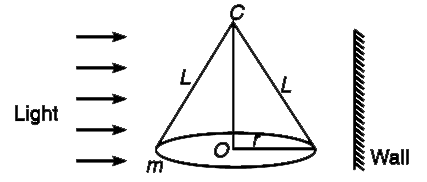A stone is swinging in a horizontal circle of diameter 0.8m at 30rev/min. A distant light causes a shadow of the stone on a nearly wall. The amplitude and period of the SHM for the shadow of the stone are
0.4m,4s
0.2m,2s
0.4m,2s
0.8m,2s
The correct Answer is:C
A=radius=Diameter2=0.4m
f=3060=12rps or 12Hz
∴T=1f=2s.
Topper's Solved these Questions
- SIMPLE HARMONIC MOTIONBOOK - DC PANDEYCHAPTER - SIMPLE HARMONIC MOTIONEXERCISE - Level 2 More Than One Correct
8 Videos
- SIMPLE HARMONIC MOTIONBOOK - DC PANDEYCHAPTER - SIMPLE HARMONIC MOTIONEXERCISE - Level 2 Comprehension
2 Videos
- SIMPLE HARMONIC MOTIONBOOK - DC PANDEYCHAPTER - SIMPLE HARMONIC MOTIONEXERCISE - Level 1 Subjective
39 Videos
- SEMICONDUCTORS AND ELECTRONIC DEVICESBOOK - DC PANDEYCHAPTER - SEMICONDUCTORS AND ELECTRONIC DEVICESEXERCISE - More than One Option is Correct
3 Videos
- SOLVD PAPERS 2017 NEET, AIIMS & JIPMERBOOK - DC PANDEYCHAPTER - SOLVD PAPERS 2017 NEET, AIIMS & JIPMEREXERCISE - Solved paper 2018(JIPMER)
38 Videos
Similar Questions
A particle of mass m is tied at the end of a light string of length L, whose other end is fixed at point C (fig), and is revolving in a horizontal circle of radius r to form a conical pendulum. A parallel horizontal beam of light forms shadow of the particle on a vertical wall.

If the tension in the string is F find -
(a) The maximum acceleration of the shadow moving on the wall.
(b) The time period of the shadow moving on the wall.
View SolutionAn object revolves uniformly in a circle of diameter 0.80 m and completes 100 rev min−1. Find its time period and angular velocity.
View Solution
Knowledge Check
A stone is swinging in a horizontal circle 1 m in diameter at 60 rev/min. A distant light causes a shadow of the stone to be formed on a nearly vertical wall. The amplitude and period of motion for the shadow of the stone are,
A0.5 m, 1sB1m, 2sC1m, 1sD0.5m, 2sA stone of mass 4kg is whirled in a horizontal circle of radius 1m and makes 2 rev/sec. The moment of inertia of the stone about the axis of rotation is
A64kg×m2B4kg×m2C16kg×m2D1kg×m2A ball attached to a string travels in uniform circular motion in a horizontal circle of 50 cm radius in 1 s. Sun light shining on the ball throws its shadow on a wall. The velocity of the shadow at the centre of the path is
Aπm/sB0.5πm/sC0.5m/sD1m/s
A certain string can withstand a maximum tensiion of 40 N without breaking. A child ties a 0.37 kg stone to one end and, holding the other end, whirls the stone in a vertical circle of radius 0.91 m, slowly increasing the speed until the string breaks. (a) Where is the stone on its path when the string breaks? (b) What is the speed of the stone as the string breaks?
View SolutionA stone tied to the end of string 1m long is whirled in a horizontal circle with a constant speed. If the stone makes 22 revolution in 44s, What is the magnitude and direction of acceleration of the ston is ?
View SolutionA stone of mass 1 kg is rotated in a horizontal circle of radius 0.5 m. If it makes 100πr.p.s. then its angular momentum is
View SolutionTwo stones of masses m and 2m are whirled in horizontal circles, the heavier one in a radius r2 and the lighter one in radius r . The tangential speed of light stone is n times that of the value heavier stone when they experience same centripetal forces. The value of n is:
View SolutionA student whirls a stone in a horizontal circle of radius 3 m and at height 8 m above level ground. The string breaks, at lowest point and the stone flies off horizontally and strikes the ground after travelling a horizontal distance of 20 m. What is the magnitude of the centripetal acceleration of the stone while breaking off.
View Solution
